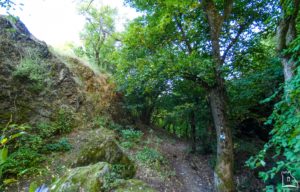Szarvaskői castle

The Szarvaskői castle is in the Bükk mountains of Hungary, it is a typical “eagle’s nest” as we call those small castles which are built on the top of a cliff. However, there is another castle in Hungary called Szarvaskő but it is located in the Bakony Mountains near Döbrönte: let us not confuse them…

The small fortification was built by the Bishop of Eger after 1261 as part of the defense system of the castle of Eger. Its name may have derived from the legend of Saint Gilles (Egyed) who was respected by the Walloon settlers who fled here in 1317 because of the famine at home. One would not imagine that once there were entire villages in Hungary where people spoke French…

The castle had always belonged to the Bishops of Eger. The small fort was also called “haversack-castle” (tarisznya vár) because its garrison was weekly changed and they brought their food from Eger in their haversacks, as there was no kitchen in it. The villages of Bakta, Bátor, Bocs, Deménd, Fedémes, Kerecsend, and Szarvaskő-alja belonged to the castle and contributed to its expenses.

King Nagy Lajos (Louis the Great) was hunting there in 1378 and stayed in the castle. Eger castle became an important stronghold in 1420 against the Bohemian Hussites so the military function of Szarvaskő became more important. As it was just 10 km from Eger, it was guarding the important trade routes leading to the city.

King Ferdinand appointed Horváth Ferenc as his captain of Szarvaskő. Horváth was terrorizing the area with his cruelty, he got hold of even the Monastery of Bél. Frangepán Ferenc demanded the castle in 1540 but Horváth had more influence with the bishop of Eger so he could keep it. Even the captains of King Szapolyai could not take the small castle back from him.

The Diet of Nagyszombat in 1545 decided that the castle should be given back to the bishop of Eger but nothing happened. Then, the Bishop of Eger became Oláh Miklós in 1548 and he could make a deal with Horváth who finally ceded the castle to the men of Dobó István a year later. Dobó, the captain of Eger, placed his man, Szalkay Balázs there. During the heroic siege of Eger in 1552, Szarvaskő had a vital function as it was giving shelter to Dobó’s spies and other agents. The castle remained in Hungarian hands but the villagers fled during the siege. You can read more about the life of Bishop Oláh Miklós here:
https://www.hungarianottomanwars.com/essays/who-was-olah-miklos-1493-1568/

The next bishop of Eger, Verancsics Antal appointed Gadóczy Gábor as its captain. A report from 1558 says that the captain neglected the castle and was just robbing the area’s inhabitants. Mágocsy Gáspár became Eger’s captain in 1568 and he was given the small castle of Szarvaskő as well. It was Cristoforo della Stella, the military engineer who was in charge of Eger castle’s renovation in 1585 who also reinforced Szarvaskő.
Eger fell in 1596 and Heves County was also taken. The unlucky Battle of Mezőkeresztes in 1596 was the greatest large-scale battle of the 15-Year War and it proved that the Christians were not ready just yet to withstand the Ottomans in the open field. After this battle, Gáll János, the captain of Szarvaskő, and his men fled to Kassa (Kosice, Kaschau), and the Turks could take Szarvaskő without any resistance. The castle belonged for 91 years to the Sanjak Area of Hatvan city. The Turks had 30-40 soldiers there and regarded it as an important castle. The area around was the land of a cavalry officer called Omar Ben Ali.

It was Colonel Alessandro Vitelli who took Szarvaskő back in 1687 without a fight because its Ottoman garrison had fled to Eger.
About 600 Turkish people of Eger and its area remained in Hungary after the end of Ottoman rule. The former Ottoman members of the garrison of Szarvaskő took the Hungarian name of “Szarvaskői” and later got assimilated into the local Hungarians. The castle was in very bad condition in 1687. There were 21 rooms in it, made of wood, and there was a small mosque, too.

Bishop István Telekessy became the landlord of Szarvaskő in 1699 and it was he who repopulated the area. He moved to live in it in 1709 and after he died in 1715, the castle gradually got ruined and literally disappeared as the locals used its stones for building up their school, church, and houses in the village. The last standing wall fell in 1910 but some windows and doors were still visible in 1931. Now, we can see a wooden cross that was erected above the castle’s Saint Miklós chapel.

Here you can find a video about the Bükk mountains of Hungary where Szarvaskő is hiding. http://www.origo.hu/utazas/hirek/20170211-pazar-dronfilm-a-bukkrol.html

Dear Readers, I can only make this content available through small donations or by selling my books or T-shirts:
Please, feel free to support me with a coffee here:
You can check out my books on Amazon or Draft2Digital, they are available in hardcover, paperback, or ebook:
https://www.amazon.com/dp/198020490X or at https://books2read.com/b/boYd81

My work can also be followed and supported on Patreon: Become a Patron!http://Become a Patron!
[wpedon id=”9140″]

https://hungarianottomanwars.myspreadshop.com/all




